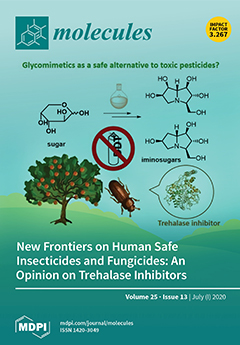A new series of methyl 2-(2-(4′-[2.2]paracyclophanyl)-hydrazinylidene)-3-substituted-4-oxothiazolidin-5-ylidene)acetates
3a–
f were synthesized from the reaction of paracyclophanyl-acylthiosemicarbazides
2a–
f with dimethyl acetylenedicarboxylate. Based upon nuclear magnetic resonance (NMR), infrared (IR), and mass spectra (HRMS), the structure of the obtained products was elucidated. X-ray
[...] Read more.
A new series of methyl 2-(2-(4′-[2.2]paracyclophanyl)-hydrazinylidene)-3-substituted-4-oxothiazolidin-5-ylidene)acetates
3a–
f were synthesized from the reaction of paracyclophanyl-acylthiosemicarbazides
2a–
f with dimethyl acetylenedicarboxylate. Based upon nuclear magnetic resonance (NMR), infrared (IR), and mass spectra (HRMS), the structure of the obtained products was elucidated. X-ray structure analysis was also used as unambiguous tool to elucidate the structure of the products. The target compounds
3a–
f were screened against 60 cancer cell lines. They displayed anticancer activity against a leukemia subpanel, namely, RPMI-8226 and SR cell lines. The activity of compound
3a was found as the most cytotoxic potency against 60 cancer cell lines. Consequently, it was selected for further five doses analysis according to National Cancer Institute (NCI) protocol. The cytotoxic effect showed selectivity ratios ranging between 0.63 and 1.28 and between 0.58 and 5.89 at the GI
50 and total growth inhibition (TGI) levels, respectively. Accordingly, compound
3a underwent further mechanistic study against the most sensitive leukemia RPMI-8226 and SR cell lines. It showed antiproliferation with IC50 = 1.61 ± 0.04 and 1.11 ± 0.03 µM against RPMI-8226 and SR cell lines, respectively. It also revealed a remarkable tubulin inhibitory activity, compared to colchicine with IC50 = 4.97 µM/mL. Caspase-3, BAX, and Bcl-2 assays for
3a using annexin V-FITC staining revealed significant pro-apoptotic activity. Furthermore, multidrug-resistant leukemia SR cells were used to show better resistance indices (1.285 ng/mL, 1.15-fold) than the reference. Docking studies with β-tubulin indicate that most of the tested compounds illustrated good binding at the colchicine binding site of the enzyme, especially for compound
3a, which made several interactions better than that of the reference colchicine.
Full article






